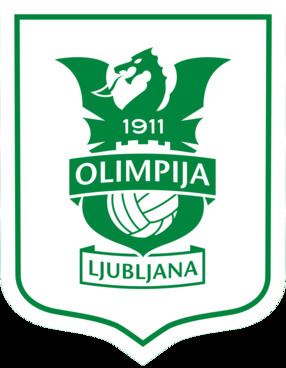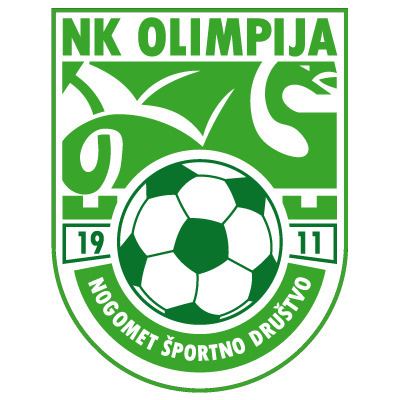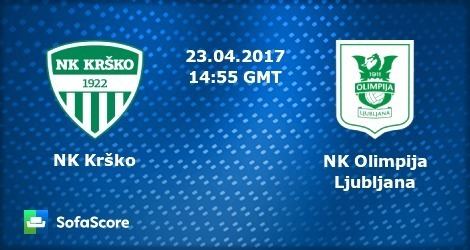Ground Capacity 16,038 Head Coach Marijan Pušnik Manager Luka Elsner Founded 1911 Chairman Milan Mandarić | President Milan Mandarić Arena/Stadium Stožice Stadium League Slovenian PrvaLiga Location Ljubljana, Slovenia | |
 | ||
Full name Športno Društvo Nogometni Klub Olimpija Ljubljana Nickname(s) Zmaji (The Dragons)
Zeleno-beli (The Green and Whites) Ground Stožice Stadium,
Ljubljana Profiles | ||
Nk olimpija ljubljana 2005
Nogometni Klub Olimpija Ljubljana ([nɔgɔˈméːtni ˈklúːp ɔˈlìːmpija ljubˈljàːna]; English: Olimpija Ljubljana Football Club), commonly referred to as Olimpija Ljubljana or simply Olimpija, is a professional association football club, based in the city of Ljubljana, Slovenia. The club competes in the Slovenian PrvaLiga, the country's highest football division.
Contents
- Nk olimpija ljubljana 2005
- Foundation
- Early years 20052009
- 1 SNL Premiere 2009
- Name changes
- Club colours and crest
- Stadium
- Supporters
- Rivalry
- UEFA club competition record
- Matches
- Honours
- First team squad
- Notable players
- References

Founded on 2 March 2005, under the name NK Bežigrad, Olimpija began competing in the Slovenian Fifth League during the 2005–06 season and have managed to achieve promotion in four successive seasons, reaching the top division for the first time in 2009, after they have won the 2008–09 Slovenian Second League. After seven years in the top division, Olimpija won their first major trophy when they were crowned champions following the 2015–16 season. Their previous best result in the top division was in the 2011–12 and 2012–13 seasons, when they were runners-up. In 2012 and 2013 they were runners-up in the Slovenian Supercup.

Originally, the club played at the Bežigrad Stadium and ŽŠD Ljubljana Stadium during the club's stay in the second division and during the first year in the top division. In 2010, they moved to the Stožice Stadium with a capacity of 16,038. The club played its opening match on the new stadium on 22 August 2010, in front of 7,000 spectators in a league match against Koper.

Olimpija's nicknames are The Green-Whites (Zeleno-beli), referring to their primary colours, and The Dragons (Zmaji), referring to the dragon which is a symbol of Ljubljana and is represented on the city's coat of arms and on the club's crest.
Foundation
Olimpija Ljubljana was founded on 2 March 2005 as NK Bežigrad, and was renamed NK Olimpija Bežigrad during their third season of existence. The club was renamed again to ŠD NK Olimpija Ljubljana on 3 March 2008 after being granted the right by the Administrative unit of the City Municipality of Ljubljana. The club regard themselves as the continuation of the four times Slovenian Champions Olimpija, also known as NK Olimpija Ljubljana, who went bankrupt and were dissolved, following the 2004–05 season. Legally Olimpija Ljubljana is distinct and separate club, and is not entitled to claim the history and honours won by the dissolved Olimpija. The Football Association of Slovenia and the Association of 1. SNL do not recognize any connection between the two entities, and keep their statistics separate. In addition, Olimpija Ljubljana was founded whilst the dissolved Olimpija was still in existence and was a member of the top division, playing their final league match on 28 May 2005 against Celje, before effectively ceasing all operations without even trying to acquire a competition license for the next season.
Originally, Olimpija Ljubljana claimed to be a new club that was formed on 2 March 2005, under the name Bežigrad. However, in 2010 they have launched their official website and adopted a new club crest with the year 1911 inscribed on it, which was claimed by the dissolved Olimpija to be their foundation year. However, the dissolved Olimpija was founded after World War II and has never been associating themselves with the year 1911 until early 1990s, when amid political turmoil during the breakup of Yugoslavia, the club began claiming direct lineage to pre-World War II club Ilirija, which was at the time playing in the Slovenian Second League. This too was never recognized by the Football Association of Slovenia, which officially recognizes Ilirija as the sole club established in 1911 to this day.
Because of their association with the dissolved club, Olimpija Ljubljana was criticised on numerous occasions by several media outlets in the country, which questioned the legitimacy of their actions and even the fact that the club has a year 1911 inscribed on their crest. They are also criticised by Ilirija. The dissolved Olimpija filed for bankruptcy after they have accumulated a debt of over 700 million Slovenian tolars (around three million euros in 2004 exchange rate). In 2013 the Davčna uprava Republike Slovenije (English: The Tax Administration of the Republic of Slovenia), or simply DURS, publicly disclosed the list of tax debtors in the country and among those was also NK Olimpija Ljubljana, with a tax debt between 100,000 and 300,000 euros. The next day Olimpija Ljubljana’s officials made a public statement where they confirmed that the club in question (i.e. dissolved Olimpija) is a different legal entity and is not, by any means, connected with Olimpija Ljubljana who competes in the top division and does not have any financial obligations to the State or any third parties.
Early years (2005–2009)
Assisted by semi-retired club legends of the old Olimpija and other notable Slovenian players, the club started to compete in the lowest tier of Slovenian football and won the fifth league in their first year. In the next two seasons, Bežigrad was promoted into the Slovenian second division, 2. SNL, by winning both fourth and third leagues in consecutive seasons. During their season in the third division the club changed its name for the first time and became known as Olimpija Bežigrad. This happened despite the claims of Joc Pečečnik, one of the wealthiest man in Slovenia and, at the time, owner of Interblock football club, that he is in fact the sole owner of the Olimpija name and brand. During the 2008–09 season, the club changed their name once again, this time to its present form Olimpija Ljubljana and during the course of the season won the second division and earned a promotion to the Slovenian first league, 1. SNL. Throughout the path to the top division, Olimpija was supported by the fan group of the dissolved Olimpija, the Green Dragons. The success of the club, who earned a promotion from the fifth league to top division in only four seasons, was somewhat dented by a conflict between several players, coaching staff, club leadership and sponsors, which eventually led to a player-led boycott in the final round of the 2008–09 season, against Triglav. Due to this event, the club began their first season in Slovenian top-flight (2009–10) with a two-point minus. In addition to that, several notable players, e.g. Miran Pavlin and Amir Karić, and staff, e.g. Danilo Popivoda, left the club.
1. SNL Premiere (2009–)
For their first ever 1. SNL campaign, several players were signed to replace the recent departures, along with a new coach, Branko Oblak. The club had a poor start, as the team, mainly composed of young players and a small number of veterans, only managed one win in the opening four matches. After their defeat against Maribor on 8 August 2009, the club announced that Oblak had agreed to terminate his contract, with assistant manager Safet Hadžić taking his place as caretaker. The club's fortunes soon turned result-wise and Robert Pevnik was hired to take over as manager. The club finished the season in fourth place.
In the run up to the 2010–11 season, principal sponsor Izet Rastoder was elected president and Safet Hadžić took over as manager. The season started poorly, with a 5–0 aggregate defeat against Široki Brijeg in the Europa League qualifying round. This game was later alleged by German TV-station ARD to have been fixed. It was later revealed that UEFA is officially investigating the match and that three players of NK Olimpija are under investigation. After another poor start which saw the club only manage two points in five matches, manager Safet Hadžić and director of football Simon Sešlar both left on 23 August 2010. Dušan Kosič then took over as manager with Aleš Čeh as his assistant. On 26 January 2011, former Slovenia international Milenko Ačimovič became the director of football at the club. After a poor start into the season the new director of football brought couple of players to the club with international experience, among which was also Slovenia national football team midfielder Dare Vršič. During the second phase of the Slovenian championship the team started to show their potential and eventually finished their second 1. SNL season on fourth place, securing a place in the Europa League qualifications. With the 3–0 home victory against Široki Brijeg on 7 July 2011, Olimpija achieved its historic first victory in UEFA competitions. Dalibor Radujko was the scorer of the club's first goal in UEFA competitions. In addition, this was the first European club match played on Stožice Stadium, opened in August 2010. During the 2011–12 Slovenian PrvaLiga season the club finished as a runner-up. In the 2015–16 season, the club won the Slovenian League title for the first time.
Name changes
Club colours and crest
Since the beginning of the club Olimpija has been playing with the combination of green and white, which were the main colours of the dissolved Olimpija. Today the club plays in white at home and in green colors away.
The kit manufacturer is Nike.
Stadium
Stožice Stadium is an association football stadium located in Ljubljana, Slovenia. It was designed by Slovenian architects Jurij Sadar & Boštjan Vuga and is the biggest Slovenian football stadium. Opened in August 2010, it is one of two stadiums in the city and lies in the Bežigrad district, north of the city centre. The stadium was named after the area in which it is located, and the change of the name is possible in the future due to sponsorship rights. Together with an indoor arena, it is a part of Stožice Sports Park. The capacity of the stadium is 16,038 covered seats. The stadium also has 558 VIP seats and 97 spots for persons with disabilities. Olimpija played its first match on the new stadium on 22 August 2010, in front of 7,000 spectators on a league match against FC Koper. The record attendance for any football club in Slovenia after its independence came in the form of a friendly match, played on Stožice Stadium, where 15,972 spectators gathered to watch Olimpija play against English Premier League side Chelsea. The stadium is also used as one of the main venues for matches of the Slovenia national football team, as well as for many cultural events such as music concerts.
Supporters
Olimpija is one of the most popular football teams in Slovenia. Their main ultras group is called Green Dragons, one of the two largest ultras groups in the country, who supported the original Olimpija until their dissolution in 2004 and had gone over to the club in 2005, as they regard it as a successor of the original club. They mostly wear green and white symbols and clothing, which are the club's colors.
Rivalry
Olimpija's biggest rivalry is with Maribor, against whom they contest the Eternal derby (Večni derbi). The original Eternal derby was contested by Maribor and Olimpija which folded and was dissolved in 2004 and today the continuation of the rivalry is considered by certain Ljubljana based media and fans, mostly of the old Olimpija, as the matches between Maribor and Olimpija, established in 2005 as Bežigrad. The rivalry traced its roots back in the early 1960s and the time of SFR Yugoslavia when the first match between the two clubs was played. The two teams represented the two largest cities in Slovenia, the capital city of Ljubljana and the second largest city Maribor, and both teams always had one of the largest fan bases in the country. Traditionally Ljubljana represents the richer western part of the country while Maribor is the center of the poorer eastern part. In addition, Ljubljana was always the cultural, educational, economic and political center of the country and Olimpija and its fans were considered as the representatives of the upper class. Maribor, on the other hand, was one of the most industrialized cities in Yugoslavia and the majority of its fans were the representatives of the working class, which means that the added tension to the rivalry was usually political, social and cultural as well. The old rivalry reached its peak in the final round of 2000–01 season when one of the most celebrated matches in Slovenian League history was played, when Olimpija met Maribor at their home stadium, Bežigrad. Both teams were competing for their fifth Slovenian League title. The home team needed a win for the title, while a draw was enough for Maribor. The atmosphere was electric days before the kick-off and the stadium with the capacity of 8,500 was completely sold out. At the end, the match ended with a draw (1–1) and Maribor started to celebrate their fifth consecutive title.
The additional intensity to the rivalry is the fact that both Maribor and Olimpija always had support on their matches from Ultras groups called Viole Maribor, supporting Maribor, and the Green Dragons who supports Olimpija. The two groups are the largest in the country and it is not uncommon that the matches between the two clubs were sometimes interrupted by violent clashes between the two groups or with the police. On many occasions, before or after the matches, the fans of the two clubs would also meet up and fight on the streets. One of the worst incidents, in April 2010 after a match, resulted in a stabbing of a member of the Green Dragons who, with a group of friends, got into a fight with members of the Viole in Ljubljana's railway station. However, to date, there has not been any fatalities in the country related to football violence. Because the new Olimpija is supported by most of the fans of the previous Olimpija, many see the matches between Maribor and the new club as the continuation of the rivalry and refer to it by the same name. However, there are many fans, either the ones from Maribor or the ones from Ljubljana, that does not share the same view and does not share similar beliefs, including part of the media (i.e. RTV Slovenija, Delo, Večer, Dnevnik). The overall statistics of the old and the new Olimpija are tracked separately by the Football Association of Slovenia and the Association of 1. SNL. The first match between Maribor and the new Olimpija took place on 24 October 2007 on a Slovenian cup quarter-final match that was won by Maribor, 3–1. At the time Olimpija was still competing under the name Olimpija Bežigrad. Overall, Maribor has been the team with more success in these matches.
UEFA club competition record
As of 20 July 2016.Matches
Honours
League
Cup
First team squad
As of 5 March 2017. The numbers are established according to the official website: www.nkolimpija.si
Note: Flags indicate national team as defined under FIFA eligibility rules. Players may hold more than one non-FIFA nationality.
Notable players
The following Olimpija players have been capped at full international level. Years in brackets indicate their spells at the club.
